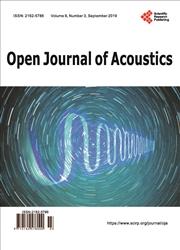Rapid Prototyping of Pyramidal Structured Absorbers for Ultrasound
引用次数: 6
Abstract
Acoustic measurements or ultrasonic testing can be strongly affected by reflections or echoes from test tank walls. In order to create a non-reflecting environment equivalent to infinite medium, a pyramidal structured absorber (PSA) can be used to coat the walls of an ultrasonic tank. In this work, we model an array of tetragonal pyramid ultrasonic wave absorbers. This model is based on two coupled first-order equations describing the stress and particle velocity within an isotropic medium. For absorbing media, the Kelvin-Voigt model of viscoelasticity is used. The equations are discretized in 2D using an efficient time-stepping pseudo-spectral scheme that takes in consideration both, the acoustic properties and attenuation characteristics of the composite materials. We then built a 3D printed PSA using a Stratasys Objet500 Connex 3D printer, which allows to combine photopolymers in specific concentrations and microstructures. We designed PSA covering the frequency ranges from 0.5 MHz to 5 MHz and from 1 MHz to 10 MHz, with double homogeneous layer: a core of rubber material with a skin of a variety of elastomers by combining rigid and flexible materials. Each single pyramid contains two major parts: the ground of the pyramid (9.4 mm base × 4.7 mm height, for 0.5 MHz and 4.7 mm base × 2.35 mm height, for 1 MHz) and the body of the pyramid (23.5 mm height, for 0.5 MHZ and 11.75 mm height, for 1 MHz). The measured echo-reduction was greater than 35 dB at the covering frequency range and the transmission loss was estimated by 20 dB. Echoes increase rapidly for frequencies below the minimum frequency of the covering range. The modeling and 3D printing of PSA with different sizes, in a wide range of frequencies, is a cost-effective custom solution for a wide range of applications including for example, radiation force balances, hydrophone mounts and medical ultrasound equipment.超声锥体结构吸波器的快速成型
声学测量或超声波测试会受到测试罐壁反射或回声的强烈影响。为了创造一个相当于无限介质的无反射环境,可以使用金字塔结构吸收器(PSA)涂覆超声罐壁。在这项工作中,我们模拟了一个四边形金字塔超声波吸收器阵列。该模型基于描述各向同性介质中应力和粒子速度的两个耦合一阶方程。对于吸收介质,采用粘弹性的Kelvin-Voigt模型。利用有效的时间步进伪谱格式将方程离散成二维,该格式同时考虑了复合材料的声学特性和衰减特性。然后,我们使用Stratasys Objet500 Connex 3D打印机构建了一个3D打印PSA,该打印机可以将特定浓度和微观结构的光聚合物结合在一起。我们设计的PSA覆盖频率范围为0.5 MHz至5 MHz和1 MHz至10 MHz,具有双重均匀层:橡胶材料的核心与通过结合刚性和柔性材料的各种弹性体的皮肤。每个金字塔包含两个主要部分:金字塔的地面(9.4毫米底座× 4.7毫米高度,0.5 MHz和4.7毫米底座× 2.35毫米高度,1 MHz)和金字塔的身体(23.5毫米高度,0.5 MHz和11.75毫米高度,1 MHz)。在覆盖频率范围内测得回波衰减大于35 dB,估计传输损耗为20 dB。当频率低于覆盖范围的最小频率时,回波迅速增加。在广泛的频率范围内对不同尺寸的PSA进行建模和3D打印,是一种具有成本效益的定制解决方案,适用于广泛的应用,例如辐射力平衡、水听器支架和医疗超声设备。
本文章由计算机程序翻译,如有差异,请以英文原文为准。
求助全文
约1分钟内获得全文
求助全文

 求助内容:
求助内容: 应助结果提醒方式:
应助结果提醒方式:


